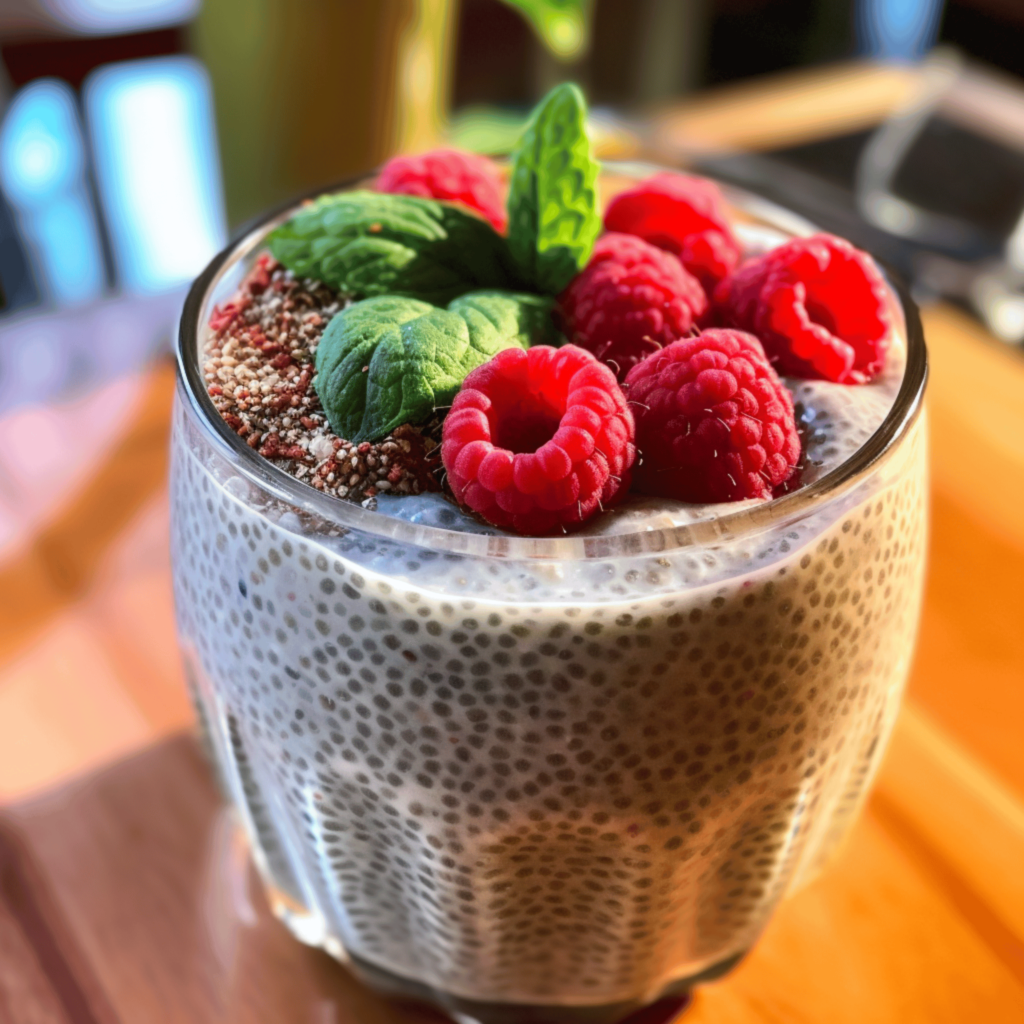Originating from the plant Salvia hispanica1, chia seeds were a staple in the diets of ancient Aztecs and Mayans. These tiny black seeds, ranging from white to brown or black, have been recognized for their significant health benefits. Despite their minute size, chia seeds pack a powerhouse of nutrients: fiber, omega-3 fatty acids, plenty of protein, and a plethora of essential minerals and antioxidants.
Nutritional Profile
Per ounce (28 grams) serving, chia seeds contain:
- Calories: 486
- Water: 6%
- Protein: 16.5 grams
- Carbs: 42.1 grams (of which 83% is fiber)
- Sugar: 0 grams
- Fat: 30.7 grams (Saturated: 3.33 grams, Monounsaturated: 2.31 grams, Polyunsaturated: 23.67 grams, Omega-3: 17.83 grams, Omega-6: 5.84 grams, Trans: 0.14 grams)
Surprisingly, they are 6% water, 46% carbohydrates (80% of which is fiber), 34% fat, and 19% protein. For those with dietary restrictions, chia seeds are also free of gluten.2
Health Benefits
1. Highly Nutritious
Chia seeds are a formidable source of nutrients, boasting more calcium than most dairy products. Essential minerals present include manganese, phosphorus, copper, selenium, iron, magnesium, and calcium.
2. Loaded with Antioxidants
Antioxidants combat oxidative stress by neutralizing free radicals.3 Free radicals, when accumulated, contribute to chronic illnesses like heart disease, cognitive decline, and various cancers. The key antioxidants present in chia seeds include Caffeic acid, Quercetin, and Kaempferol.
3. Weight Management
The high fiber content can contribute to feelings of fullness, potentially leading to reduced calorie intake and supporting weight loss endeavors.
4. Heart Health
High in omega-3 fatty acids, especially alpha-linolenic acid (ALA), chia seeds may reduce the risk of heart disease. The benefits are further amplified if they promote a lower omega-6 to omega-3 ratio, compared to alternatives like flaxseed.
5. Supports Bone Health
With key bone nutrients like calcium, phosphorus, and magnesium, chia seeds might be instrumental in maintaining bone strength.
6. Blood Sugar Regulation
Chia seeds help improve blood sugar control, making them beneficial for those monitoring their glycemic response.
7. Digestive Health
The fiber content in chia seeds may help improve digestive health, providing relief from bloating, constipation, and inflammatory bowel conditions.
Consumption and Considerations
Chia seeds can be incorporated into various dishes, from salads or yogurt to chia kombucha and granola. They can be consumed whole, unlike flaxseed, and are often added to water, creating a very thin, gel-like consistency termed chia seed water.
However, their water-absorbing property can pose a choking hazard, especially if consumed dry. Thus, individuals with swallowing difficulties or young children should be cautious.

Varieties and Cultivation
Chia seeds, with their impressive nutritional benefits, have garnered global attention. As a result, several varieties of chia seeds have been cultivated across different regions.
1. Salba Chia
Often referred to as the ‘super chia,’ Salba chia is one of the most nutrient-dense varieties of chia seeds. Originating from selective breeding within the Salvia hispanica species, Salba chia boasts a consistent nutrient profile. It has a whitish hue compared to other varieties and is grown under specific conditions to maintain its nutrient consistency.
2. Mexican Chia
Indigenous to Mexico, this variety is often darker and can range from black to grey. Known for its robust growth, the Mexican chia thrives in the native Mexican climate, drawing its unique nutrient composition from the region’s soil.
3. Guatemalan Chia
Hailing from Central America, specifically the highlands of Guatemala, this variety is cultivated in cooler climates. The seeds have a more varied color palette, from white to black, and are often smaller than the Salba and Mexican varieties.
4. Australian Grown Chia
As the global demand for chia seeds surged, Australia became one of the leading producers of chia seeds. The variety cultivated here, though similar in appearance to Mexican chia, has its unique nutrient profile, influenced by Australia’s distinctive soil and climatic conditions.
5. Peruvian Chia
Originating from the high-altitude regions of Peru, this chia variety has a blackish hue and is known for its high omega-3 content. The unique climatic conditions of Peru, with its warm days and cool nights, give this chia seed a distinct flavor profile.
Cultivation Insights
The cultivation of chia seeds largely depends on the region and its associated climate.4 They are typically grown in well-draining soils, with plenty of sunlight exposure. While they are drought-resistant to some extent, chia plants flourish with moderate rainfall.
As flowering plants of the mint family, chia plants are pollinated by bees and produce vibrant blue, purple, or white flowers, which subsequently develop into seed pods.
During harvest, mature chia plants stand around 3 to 4 feet tall. The seed pods are threshed to extract the chia seeds, which are then cleaned and dried for consumption. Throughout the cultivation process, chia plants require minimal intervention, making them a relatively sustainable crop.

Conclusion
Chia seeds, whether manifested as diminutive black specks or shades spanning from white to brown or even black, encapsulate a plethora of health benefits. Their nutrient-dense composition, coupled with prospective protective effects against cardiovascular diseases, cancer, and other prolonged health challenges, establishes them as a commendable inclusion in contemporary nutrition. As with all nutrient-rich foods, it’s prudent to consume them in moderation and seek guidance from a healthcare expert when incorporating them regularly.
FAQs
Does chia seeds have any side effects?
Consuming chia seeds in moderation is generally safe. However, overconsumption can cause digestive issues such as diarrhea, bloating, and stomach cramps due to their high fiber content. It’s best to stick to recommended amounts.
Is it good to drink chia seeds every day?
Consuming chia seeds daily can offer various health benefits due to their nutrient richness. However, it’s essential to moderate your intake. Overconsumption, especially if you’re not accustomed to high-fiber foods, can cause digestive discomfort like bloating or diarrhea. A typical recommendation is 20 grams or approximately 1.5 tablespoons twice daily.
Are chia seeds gluten-free?
Yes, chia seeds are naturally gluten-free, making them suitable for individuals with celiac disease or gluten sensitivity.
How can I incorporate chia seeds into my meals?
Chia seeds are versatile. They can be sprinkled on salads, added to smoothies, used in baking, or soaked to create a pudding-like consistency.
Do chia seeds interact with medications or health conditions?
Due to their high fiber content, chia seeds can affect medication absorption. If you’re on medication or have a health condition, it’s wise to consult a doctor before adding chia seeds to your diet in significant amounts.
Sources
- “Health Benefits of Chia Seeds.” WebMD, www.webmd.com/diet/health-benefits-chia-seeds. Accessed 8 Sept. 2023. ↩︎
- “Chia Seeds 101.” Healthline, 8 June 2021, www.healthline.com/nutrition/chia-seeds#nutrition. Accessed 8 Sept. 2023. ↩︎
- “6 Health Benefits of Chia Seeds.” Forbes Health, 25 May 2023, www.forbes.com/health/body/chia-seeds-benefits/. Accessed 8 Sept. 2023. ↩︎
- “Chia Seeds Cultivation (Sabja), Farming Practices | Agri Farming.” Www.agrifarming.in, www.agrifarming.in/chia-seeds-cultivation-sabja-farming. Accessed 8 Sept. 2023. ↩︎




































